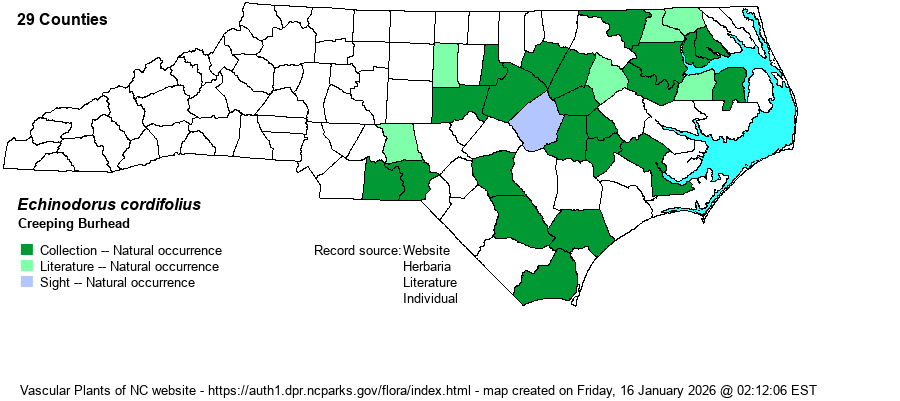| Section 5 » Order Alismatales » Family Alismataceae |
Show/Hide Synonym
| taxonName | relationship | relatedTaxonName | relatedTaxonRefText | relComments |
|---|
|
|
|
|
|
|
|
|
| Echinodorus cordifolius | > | Echinodorus cordifolius ssp. cordifolius | Flora of North America (1993b, 1997, 2000, 2002a, 2002b, 2003a, 2004b, 2005, 2006a, 2006b, 2006c, 2007a, 2009, 2010) | | | Echinodorus cordifolius | > | Echinodorus cordifolius var. cordifolius | Gleason and Cronquist (1991) | | | Echinodorus cordifolius | = | Echinodorus radicans | Small (1933, 1938) | | | Source: Weakley's Flora |
|
| Author | (L.) Grisebach | |
| Distribution | Scattered over nearly all of the Coastal Plain, barely west to the eastern Piedmont. Ranges west only to Alamance, Chatham, and Anson counties (Pee Dee NWR). Absent from the Sandhills.
This is a Coastal Plain species, occurring north to MD and south to central FL and southern TX. It is absent from the Mountains and most of the Piedmont province. It is numerous in counties close to the Mississippi River, north to IL and IA, a portion of the Coastal Plain termed the Mississippi Embayment. Also southward through much of the Neotropics. | |
| Abundance | Uncommon in the Coastal Plain, and rare to locally very uncommon in the eastern Piedmont. Seems to be rare in coastal counties and not recorded from the Outer Banks. | |
| Habitat | This is another marsh species, being found in very muddy ground or very shallow water, such as along pond margins, river oxbows and meanders, muddy places in marshes, and openings in swamps and wet bottomlands. Weakley (2018) mentions that it has a preference for higher pH soils, which may account for its general scarcity in the state despite occurring in widespread marshy habitats. | |
| Phenology | Blooms from June into November, and fruits shortly after flowering. | |
| Identification | This is another marsh-dwelling monocot with large leaf blades. The several leaves have stalks up to 1 foot long, topped by a somewhat widely ovate blade that is about 5-6 inches long and across, often with a squared-off base. The upper surface of the blade has conspicuous and deep curved veins. This species is odd in that the flowering stem is often 2 feet or longer, often drooping to the ground and rooting at nodes, producing a "creeping plant". At a handful of nodes along this stem grow several clusters of flowers, each 3-petaled and white in color, about 3/4-inch across. As with Alisma subcordatum, this is another marsh species with large leaves and an odd inflorescence, though in this species the inflorescence is long and slender with whorls of moderate-sized flowers. Despite it occurring in common marsh or mud habitats, it is barely encountered once a year by many biologists, but once seen it is not easily forgotten. | |
| Taxonomic Comments | None
| |
| Other Common Name(s) | Spade-leaf Sword. The "bur" part of the common name is sometimes written as "burr". | |
| State Rank | S3 | |
| Global Rank | G5 | |
| State Status | | |
| US Status | | |
| USACE-agcp | OBL link |
| USACE-emp | OBL link |

